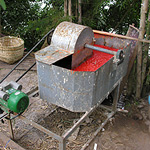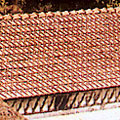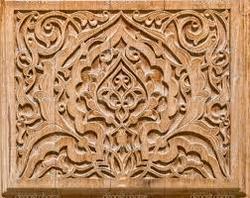Fine natural paper, made by hand, from the local saa or paper mulberry tree (broussonetia papyrifera), represents an unbroken tradition of papermaking, common across the South East Asian region, going back to over 700 years and possibly tracing its origin to the ancient art of papermaking in China. The paper mulberry tree is a small deciduous tree native to Asia, which grows easily in this region. It is the inner bark of this tree that is used for making paper, not the pith nor the wood.
Traditionally, this paper has been used for religious and ceremonial purposes on account of its lustre and incredible strength.
MATERIALS
Found in abundance, the paper mulberry tree grows and thrives in open, moist, forest and naturally irrigated areas. Proliferating easily, it is an environmentally friendly source of renewable raw material when compared to wood, and easier to process. The paper mulberry is a small tree with light brown bark that grows in tall clump like large bushes with full drooping green leaves that blossom out from the middle upward. On older larger trees, the bark can often be yellowish at the base. It is the bark of the branches that is used to produce paper.
Hemp fibers have also been known to be used as paper, though not so commonly in Laos.
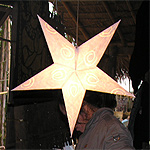
PROCESS
The process is more or less common across the region; is time consuming, labour intensive and requires good weather conditions.
 |
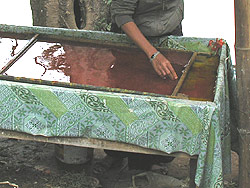 |
The branches of the paper mulberry shrubs are harvested in the fall, so that they can be stored and processed in the winter months, as the branches spoil in the humid summer heat. The branches are cut to a size of about two to three feet in length and then steamed for about three hours. The steam shrinks and loosens the bark, which is then pulled off the branches like a peel. The bark, thus removed, can be used immediately for the production of paper or is often dried and stored, to be used later.
If dried strips of bark are used for the making the paper, they are first soaked in water, overnight or longer, until the bark is soft and ready to be processed further. The bark has three layers: black bark, which is the outermost layer; green bark, the middle layer; and white bark, the innermost layer. These layers of the bark are seperated according to the colour. All three are used for making paper, but the finest paper is made with the white bark only.
At this stage most of the knotted and tough fibres are also removed. The soft, pliable bark strips are then cooked for several hours, in huge drums, in a mixture of water and soda ash or caustic soda. The soda bleaches the fibres and causes them to break down further so as to allow them to be pulled apart easily. The colour of the bark is off white, at this stage, the natural color of saa paper. The strips are then rinsed several times in clean water to rinse off the soda ash. Rinsing also makes the fibre brighter and whiter.
Each bark strip is further individually inspected, and all impurities are removed, leaving a completely pure white bark. The scraped, cooked, and cleaned pulpy strips are then beaten by large wooden mallets, until they become a smooth mixture. The beating is sometimes done mechanically.
This pounded smooth mixture is stored in large vats and stirred with long bamboo poles until flakes rise to the surface. A polyethylene oxide is added to the mixture to help slow the flow of water, which gives the papermaker more time to form sheets. The mixture is poured through a fine mesh screen which acts as a sieve onto the wooden framed screens. Each screen is approximately 1 ½ feet by 2 feet and the flakes settle on the surface while the water runs through, creating a single sheet of paper. The screens are then taken outside and dried in the sun.
This finished paper is peeled from the screens by hand and piled in stacks for use. Colour and design can be added by putting vegetable dyes into the pulp, or is put through other decorative processes like batik or printing. Petals of flowers or leaves are often added to the paper as decoration.
PRODUCTS AND MARKETS
Traditionally saa paper was used for calligraphy and religious purposes, for making temple decorations, fans and kites. It was also used at one time as a filter in the manufacture of lacquerware. In recent years, it is being used to create lampshades, writing paper, greetings cards and bookmarks, photo albums, boxes, notebooks, wrapping paper and gift paper and Buddhist Lenten stars. The paper is even waterproofed and used in the manufacture of parasols.
 |
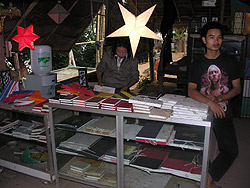 |
FRESH INITIATIVES
Handcrafted paper is available in Vientiane and Luang Prabang. In an environmentally-focused initiative, the Japan International Co-operation Agency (JICA) and Laos, through their joint programme, the Forest Conservation and Afforestation Project (FORCAP), have taught villagers in the Vientiane Province the techniques that combine both Japanese and Lao weaving and papermaking. Saa paper is used for weft and cotton or silk for warp; yarns are dyed with natural materials and woven into local patterns.
Gallery
YOUR VIEWS
PRACTITIONERS: INDIA
Access 70,000+ practitioners in 2500+ crafts across India.
BIBLIOGRAPHY
10,000+ listings on arts, crafts, design, heritage, culture etc.
GLOSSARY
Rich and often unfamiliar vocabulary of crafts and textiles.
SHOP at India InCH
Needs to be written.
